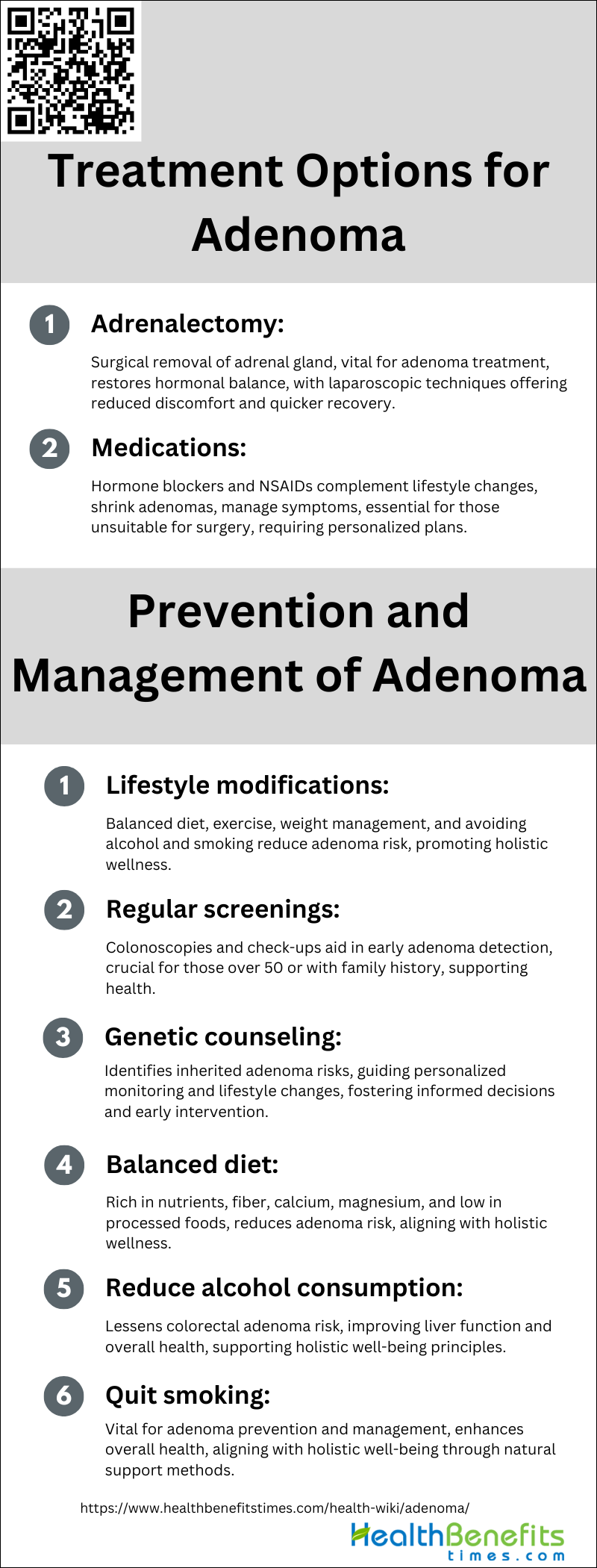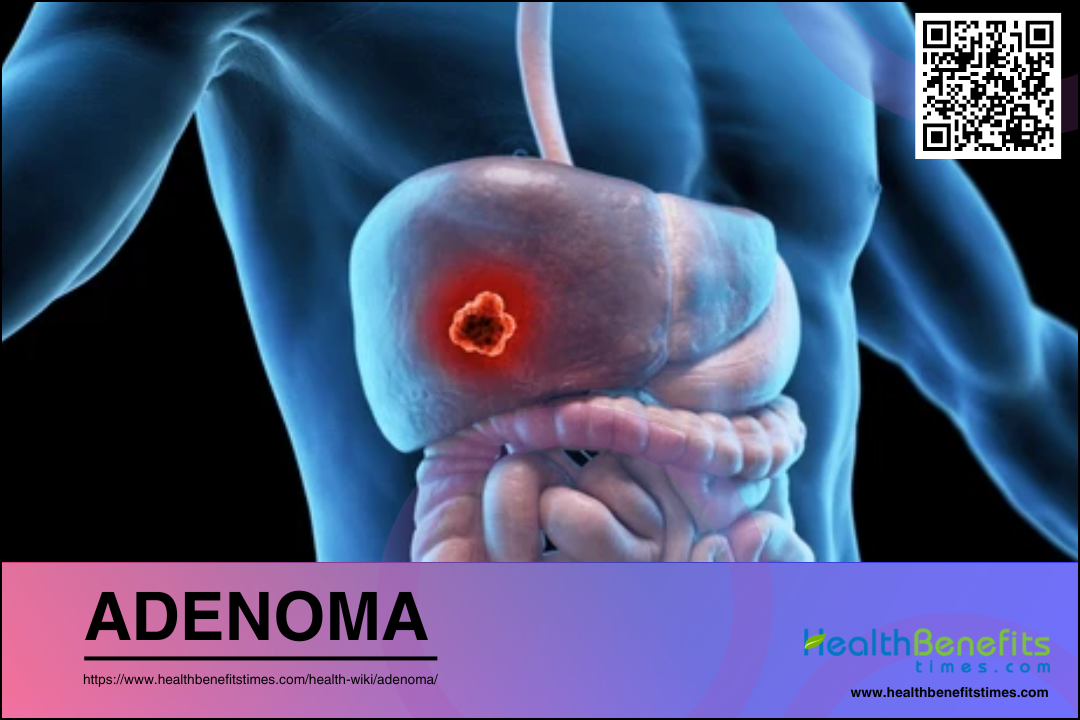 Adenomas are benign tumors that originate from the epithelial tissue of glands, playing a significant role in the body’s health and signaling potential imbalances. It is important to recognize these non-cancerous growths as more than isolated conditions on a website dedicated to holistic health, fitness, and wellness, as they can serve as precursors to cancer and disrupt bodily functions, leading to health issues. Adenomas can develop in various organs, including the colon, liver, adrenal glands, and pituitary glands, each with specific symptoms and risks. Early detection and management of adenomas are crucial in preventing their progression to malignant tumors. By educating our readers about the signs, risks, and the importance of a balanced lifestyle and regular health screenings, we aim to promote proactive health measures and overall well-being.
Adenomas are benign tumors that originate from the epithelial tissue of glands, playing a significant role in the body’s health and signaling potential imbalances. It is important to recognize these non-cancerous growths as more than isolated conditions on a website dedicated to holistic health, fitness, and wellness, as they can serve as precursors to cancer and disrupt bodily functions, leading to health issues. Adenomas can develop in various organs, including the colon, liver, adrenal glands, and pituitary glands, each with specific symptoms and risks. Early detection and management of adenomas are crucial in preventing their progression to malignant tumors. By educating our readers about the signs, risks, and the importance of a balanced lifestyle and regular health screenings, we aim to promote proactive health measures and overall well-being.
Types of Adenomas
Understanding the various types of adenomas is essential for identifying their symptoms and effectively managing their effects. In this study, we examine the prevalent types of adenomas, emphasizing their locations and potential health consequences.
1. Pituitary Adenomas
Pituitary adenomas are classified by hormone production and clinical symptoms, with some being silent despite hormone immune-positivity. Pituitary adenomas are benign growths in the pituitary gland located at the base of the brain. They often do not cause symptoms, but can potentially result in vision problems, hormonal imbalances, and fatigue. These tumors are classified as either functioning or nonfunctioning, with the former possibly leading to conditions such as Cushing’s disease or acromegaly due to excess hormone production, and the latter potentially causing pressure on brain structures. Effective management of these adenomas is crucial and may involve a combination of medical treatments, dietary modifications, stress management, and lifestyle changes.
2. Adrenal Adenomas
Adrenal adenomas are benign tumors of the adrenal cortex with varying functionality. They can be classified into different types based on their hormonal activity and appearance. Black or brown adenomas, often associated with Cushing’s syndrome, have a higher radiological density and lower serum aldosterone levels compared to yellow adenomas. These noncancerous growths may remain asymptomatic until they are incidentally discovered during imaging tests for other conditions. Functioning adenomas have the potential to disrupt the body’s hormonal balance by overproducing hormones such as cortisol or aldosterone, which can lead to conditions like Cushing’s syndrome or Conn’s syndrome. These conditions are characterized by symptoms such as high blood pressure, obesity, and muscle weakness. On the other hand, nonfunctioning adenomas typically do not impact hormone levels and are usually asymptomatic. It is important for individuals to be vigilant about potential hormonal imbalances and to engage in stress management, a nutritious diet, and regular exercise to support adrenal function and overall health.
3. Thyroid Adenomas
Thyroid adenomas are benign tumors of the thyroid gland that can impact both physical and emotional health by disrupting hormonal balance. These growths are often found incidentally during ultrasound exams and can result in hyperthyroidism if they become functionally active and produce excess thyroid hormones. Thyroid adenomas are benign tumors with various subtypes, including follicular adenomas, which are common and encapsulated, lacking invasive features. Symptomatic adenomas, which can lead to issues like swallowing difficulties or hormonal imbalances, may require treatments such as radioactive iodine therapy, surgery, or radiofrequency ablation. Overall, managing thyroid adenomas involves maintaining a balanced diet, reducing stress, and focusing on overall wellness to support thyroid health and the body’s natural healing abilities.
4. Colorectal Adenomas
Colorectal adenomas, also known as polyps, are noncancerous growths in the colon and rectum that can serve as precursors to colorectal cancer. Colorectal adenomas are precancerous lesions, classified into various types based on morphology and histology. Protruded-type adenomas are less likely to harbor KRAS mutations compared to flat-type adenomas, which frequently exhibit these mutations, particularly in the distal colon. Tubular adenomas, characterized by a tubular structure, have a lower likelihood of developing into cancer compared to villous adenomas, which have a finger-like structure and present a higher risk, particularly when they are large. Tubulovillous adenomas exhibit features of both types and also carry a significant cancer risk. Early detection through screening is vital in preventing the potential progression of these adenomas into malignant tumors, highlighting the importance of proactive health maintenance practices.
5. Hepatic Adenomas
Hepatic adenomas, also known as hepatocellular adenomas, are rare benign liver tumors that are often influenced by hormones and primarily affect women, particularly those with elevated estrogen levels from oral contraceptives or anabolic steroids. These tumors may be asymptomatic but can cause discomfort in the upper right abdomen and, in rare instances, serious complications such as hemorrhage or malignant transformation. They are classified into various subtypes, including inflammatory, HNF1A-mutated, and β-catenin activated adenomas, each with differing risks of complications. For example, inflammatory adenomas are the most common and are linked to obesity or metabolic syndrome, while β-catenin activated adenomas have a higher likelihood of bleeding and cancer, especially in males.
6. Pleomorphic adenomas
Pleomorphic adenomas, the most common type of salivary gland adenomas, exhibit diverse histological features. They are classified into two main types: Type 1, characterized by spindle cells and mucinous material production, and Type 2, primarily composed of ductal cells with little mucinous area. They are composed of a variety of cells that give them a distinct appearance under a microscope and typically present as slow-growing, painless lumps near the jawline or ears. Despite their benign nature, there is a risk of malignant transformation if left untreated, highlighting the importance of early detection and treatment. A comprehensive approach to managing these tumors would involve a combination of medical intervention and lifestyle modifications, such as stress reduction and dietary changes, to promote overall well-being and prevent potential complications, including the rare progression to malignancies like carcinoma ex-pleomorphic adenoma.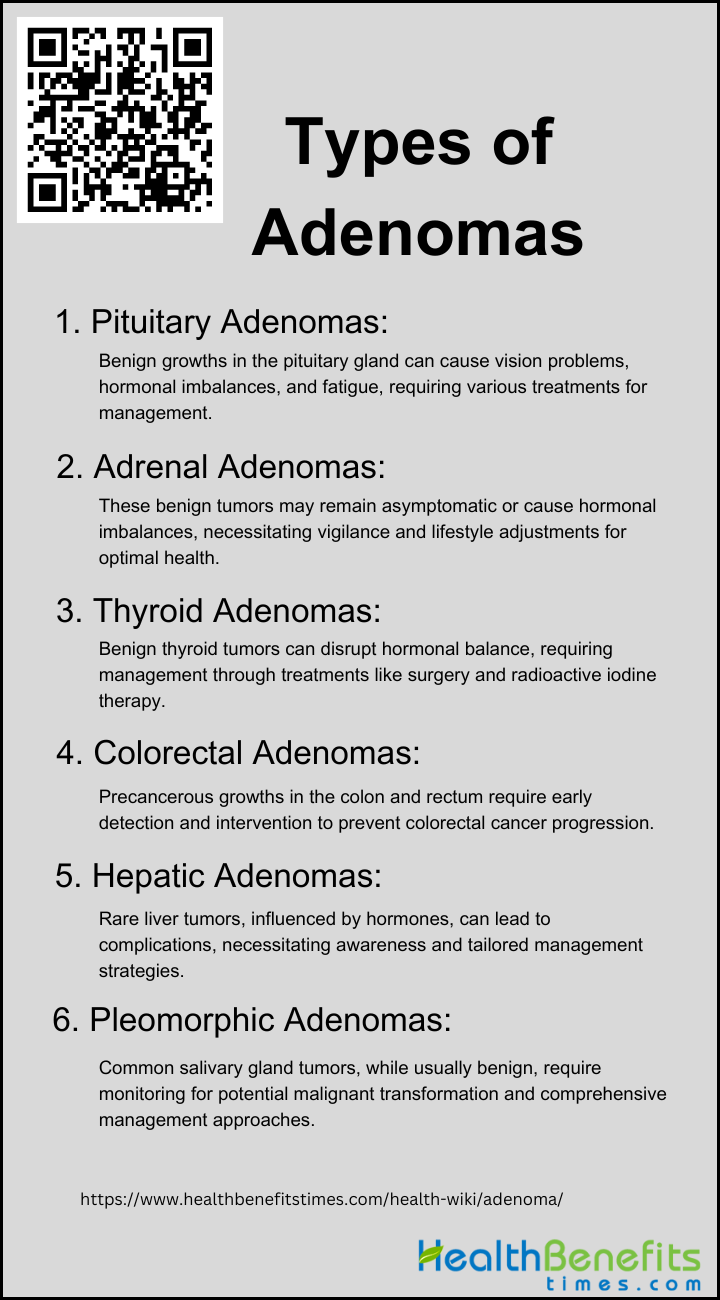
Causes and Risk Factors of Adenoma
Understanding the causes and risk factors of adenomas is essential in the field of holistic health, as it enables individuals to make informed decisions about their well-being. Adenomas, which are benign tumors that originate from glandular tissue, can have various contributing factors including genetic predispositions and lifestyle choices. In this study, we explore the key elements that can elevate the risk of developing an adenoma, laying the groundwork for both awareness and prevention strategies.
1. Age
As individuals age, the risk of developing adenomas, benign tumors that can occur in various organs, increases. Age is a significant factor in the development of colorectal adenomas. Older age is associated with an increased risk of adenomas, with a notable rise in risk for individuals aged 60 years and above. The increase in risk is attributed to the natural aging process, which can result in less effective DNA repair and the accumulation of cellular damage. Regular health screenings, such as colonoscopies, become increasingly important as individuals reach their 30s and 40s, as they can aid in the early detection and removal of adenomas. Adopting a holistic approach to health, which includes a balanced diet, regular exercise, and stress management, is crucial for supporting cellular health and may help reduce the risk of adenoma development. Taking a proactive approach to health is essential for maintaining well-being and preventing the progression of potential chronic diseases as individuals age.
2. Ethnic Background
Ethnic background has a significant impact on the risk of developing adenomas, which are benign tumors found in various organs. Research has shown a notable variation in risk among different ethnic groups. For example, African Americans have a higher rate of colorectal adenomas, possibly due to genetic factors and lifestyle habits. Ashkenazi Jews also face increased risks due to genetic predispositions. Hispanics and East Asians, on the other hand, have a higher tendency for certain types of adenomas such as tubular adenomas and adenocarcinomas. Recognizing these differences is crucial for developing personalized prevention and screening strategies that take into account both genetic and environmental influences. This approach aligns with a holistic health perspective that emphasizes tailored care for individuals, especially those from high-risk backgrounds. It is recommended to undergo regular screenings and have informed discussions with healthcare providers to proactively address and reduce the risks associated with adenomas.
3. Genetic predispositions
Genetic predispositions play a significant role in the development of adenomas, which are precursors to colorectal cancer (CRC). Inherited conditions like familial adenomatous polyposis (FAP) and Lynch syndrome increase the risk of developing adenomas, often requiring regular health screenings and genetic counseling for individuals with a family history of these conditions. Lifestyle factors, such as obesity, a diet high in processed foods and red meat, and certain behaviors, can also contribute to this risk. Understanding one’s genetic predisposition and making informed lifestyle changes are essential components of a comprehensive health strategy aimed at preventing adenomas and promoting overall well-being through personalized care and vigilant monitoring.
4. Hormonal imbalances
Hormonal imbalances play a significant role in the formation of adenomas, benign tumors that can impact various glands in the body. These imbalances, caused by either an overabundance or deficiency of hormones such as estrogen, progesterone, testosterone, and those produced by the thyroid and pituitary glands, can be influenced by genetic factors, lifestyle choices, medications, and environmental exposures. Conditions like polycystic ovary syndrome (PCOS) can elevate androgen levels, leading to the development of ovarian adenomas, while an excess of growth hormone can result in pituitary adenomas. Adenomas themselves can disrupt hormone regulation by producing excessive hormones. A comprehensive approach to health, including proper nutrition, regular physical activity, stress management, and medical treatment when necessary, is crucial for maintaining hormonal balance, reducing the risk of adenomas, and promoting overall endocrine health.
5. Environmental factors
Environmental factors play a significant role in the development of adenomas, benign tumors that can occur in various organs and potentially progress to cancer, particularly colorectal cancer. Lifestyle choices, such as a diet high in red and processed meats, have been associated with an increased risk of these tumors, while consuming ample fruits, vegetables, and fiber may provide protection. Exposure to industrial chemicals found in plastics and pesticides, as well as tobacco smoke and heavy alcohol consumption, are also notable risk factors. Additionally, obesity and a sedentary lifestyle further increase the risk. It is estimated that approximately 83% of colorectal cancer cases are attributed to these environmental factors. Adopting a holistic approach to health, including a balanced diet, regular exercise, and minimizing exposure to harmful substances, is crucial in reducing the risk of adenomas and promoting overall well-being.
6. Lifestyle choices
Adopting a healthy lifestyle is crucial for reducing the risk of adenomas, benign tumors that can potentially progress to colorectal cancer if left untreated. Key risk factors include a diet high in red and processed meats, obesity, smoking, and excessive alcohol consumption, all of which can elevate the chances of developing these growths. Conversely, regular physical activity and a well-balanced diet rich in fruits, vegetables, and whole grains have been proven to significantly decrease the risk. It is essential to recognize and modify these lifestyle habits as part of a comprehensive approach to health and well-being, not only to prevent adenoma formation but also to promote overall colorectal health.
7. Multiple endocrine neoplasia, type 1 (MEN1)
Multiple endocrine neoplasia, type 1 (MEN1) is a hereditary disorder that increases the likelihood of developing endocrine tumors, such as adenomas, due to mutations in the MEN1 gene. This gene typically controls cell growth and tumor suppression. Individuals affected by MEN1 often develop tumors in the parathyroid, pancreas, and pituitary glands, which can disrupt hormonal balance and impact overall health. It is crucial for individuals with MEN1 to undergo early detection and regular monitoring, as well as comprehensive care that address the physical and emotional challenges of the condition. By understanding the genetic basis and risks associated with MEN1, patients and healthcare providers can take informed, proactive steps to protect health and prevent further complications, including cancer. Regular screenings and genetic counseling are recommended, particularly for individuals with a family history of MEN1, to effectively manage and reduce the associated risks.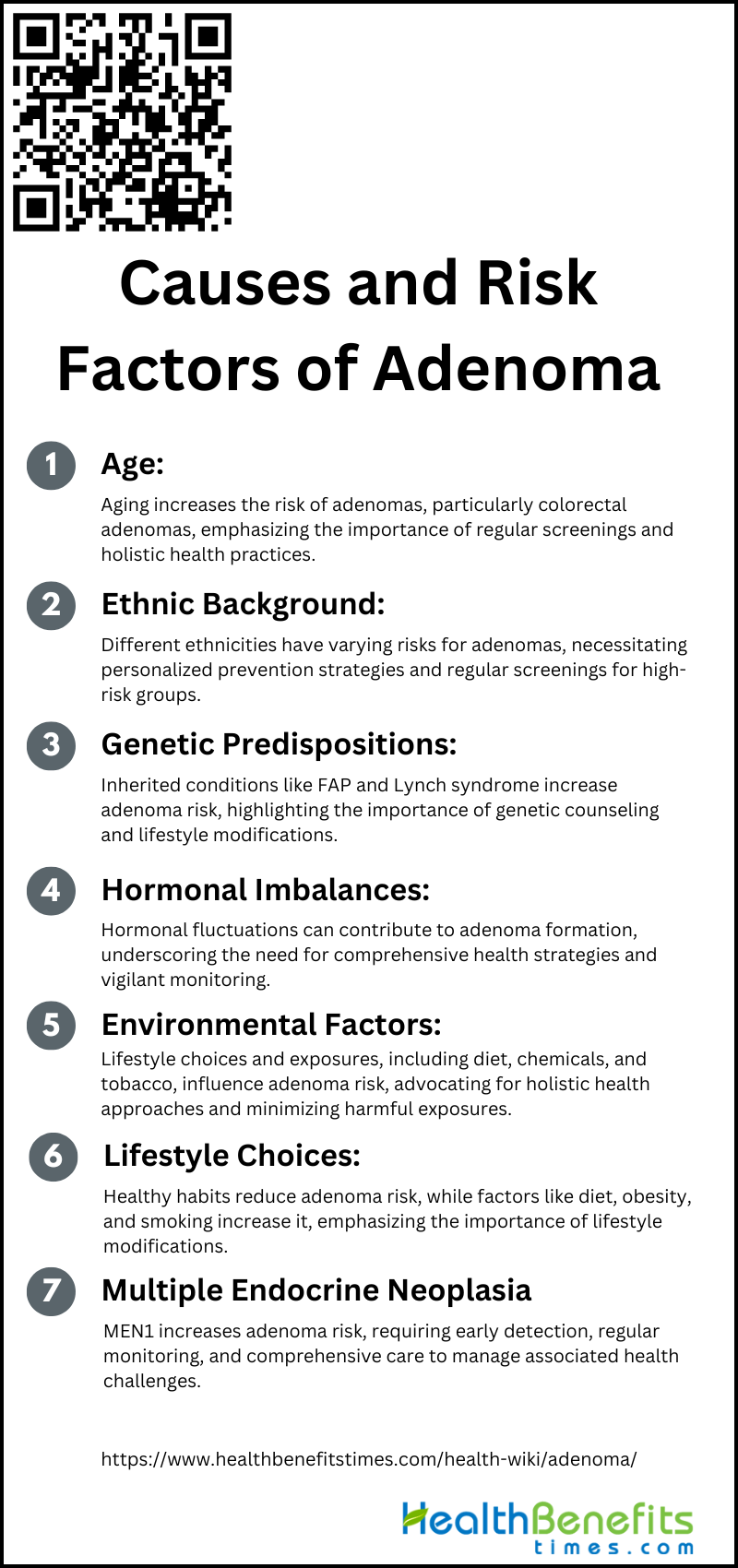
Symptoms of Adenoma
Adenomas are benign tumors that can develop in different organs, affecting one’s health in subtle ways. Recognizing symptoms and understanding the diagnostic process are important steps in managing these growths comprehensively. Here, we describe the key signs and diagnostic methods that are essential for identifying adenomas.
1. Abdominal pain
Abdominal pain is a common symptom that may indicate the presence of adenomas in the gastrointestinal tract or endocrine glands, affecting digestion. The severity of the discomfort can range from mild to severe and may be accompanied by symptoms such as nausea, vomiting, and bloating. Large adenomas, particularly those in the liver, can cause significant pain due to bleeding or tissue pressure, while adenomas in the gastrointestinal tract may result in jaundice and bleeding. It is important for individuals interested in holistic health to understand that although adenomas are usually noncancerous, persistent abdominal pain should prompt a visit to a healthcare provider.
2. Fatigue
Fatigue is a prevalent and debilitating symptom in patients with adenomas, as evidenced by its significant presence in cancer survivors, including those with primary pituitary adenomas. The pituitary or adrenal glands growths can disrupt the body’s hormonal balance, leading to profound and persistent tiredness that impacts daily functioning and overall well-being. The diagnosis of fatigue necessitates a comprehensive assessment, including a review of medical history, physical examinations, and hormone level testing, as well as MRI or CT scans to identify the characteristics of the adenoma.
3. Headache
Headaches, whether persistent or intermittent, are a common symptom of adenomas, particularly when these noncancerous growths are located in the pituitary gland or brain. Headaches are a prominent symptom of pituitary adenomas, often correlating with the tumor’s characteristics. Studies show that adenoma type influences headache severity, with functional microadenomas, particularly prolactinomas, causing more intense headaches. These tumors can exert pressure on surrounding tissues and nerves, resulting in pain that is not alleviated by conventional treatments. In the field of holistic health, a comprehensive understanding of the body’s intricate systems is essential for identifying such conditions. This approach integrates medical interventions with holistic approaches to alleviate pain and prevent complications, recognizing that headaches may also arise from the hormonal impact of the adenoma on the body’s endocrine system.
4. Iron deficiency, anemia
Iron deficiency anemia is often a characteristic indicator of an adenoma in the gastrointestinal tract or liver, resulting in symptoms such as fatigue, shortness of breath, and dizziness due to chronic blood loss and decreased hemoglobin levels. These adenomas may not always be immediately associated with such symptoms, but they can lead to slow and concealed bleeding that exhausts iron reserves, essential for hemoglobin production. Symptoms of iron deficiency anemia include fatigue, hair loss, and restless legs. A comprehensive health perspective emphasizes the importance of not only treating the adenoma but also providing nutritional support and lifestyle changes to address the iron deficiency and enhance overall well-being. Early recognition of these symptoms is crucial for preventing the progression of anemia and effectively managing the adenoma.
5. Muscle weakness
Muscle weakness, although often a subtle symptom, can indicate the presence of adenomas, including those in the pituitary and adrenal glands, which disrupt the body’s hormonal balance. Excessive hormone production by these tumors, such as cortisol in the case of pituitary adenomas, can result in conditions like Cushing’s syndrome, characterized by decreased muscle strength and increased fat accumulation. This weakness may become noticeable during daily activities such as climbing stairs or standing up from a chair. A holistic approach to health emphasizes the importance of timely medical evaluation to uncover the underlying causes and develop a personalized wellness plan, recognizing the connection between physical symptoms and hormonal equilibrium.
6. Rectal bleeding
Rectal bleeding is a significant symptom of colorectal adenomas and cancer, with positive predictive values (PPVs) ranging from 2.2% to 16% in individuals aged 50 years and above. While rectal bleeding often originates from benign anal conditions, it necessitates thorough investigation due to the risk of colorectal malignancies. It is commonly associated with less serious conditions like hemorrhoids; it should not be ignored as it could also be a sign of more serious issues, such as colorectal cancer. When adenomas lead to bleeding, it is typically due to disruption of normal tissue or growth significant enough to cause harm to surrounding areas. Healthcare professionals utilize examinations such as digital rectal exams, colonoscopies, and imaging tests to diagnose adenomas, evaluating their size, location, and potential for malignancy. If you observe blood in your stool or on toilet paper, it is crucial to promptly seek medical attention to determine the underlying cause and receive appropriate treatment.
7. Dizziness
Dizziness is a common complaint in emergency departments and neurology offices, and while often benign, it can occasionally signal serious neurological conditions, including brain tumors like adenomas. While this feeling of spinning or unsteadiness is not typically the most common indication of adenomas, when it is accompanied by symptoms such as changes in vision, fatigue, and headaches, it could suggest hormonal imbalances or pressure on brain structures due to the tumor’s growth.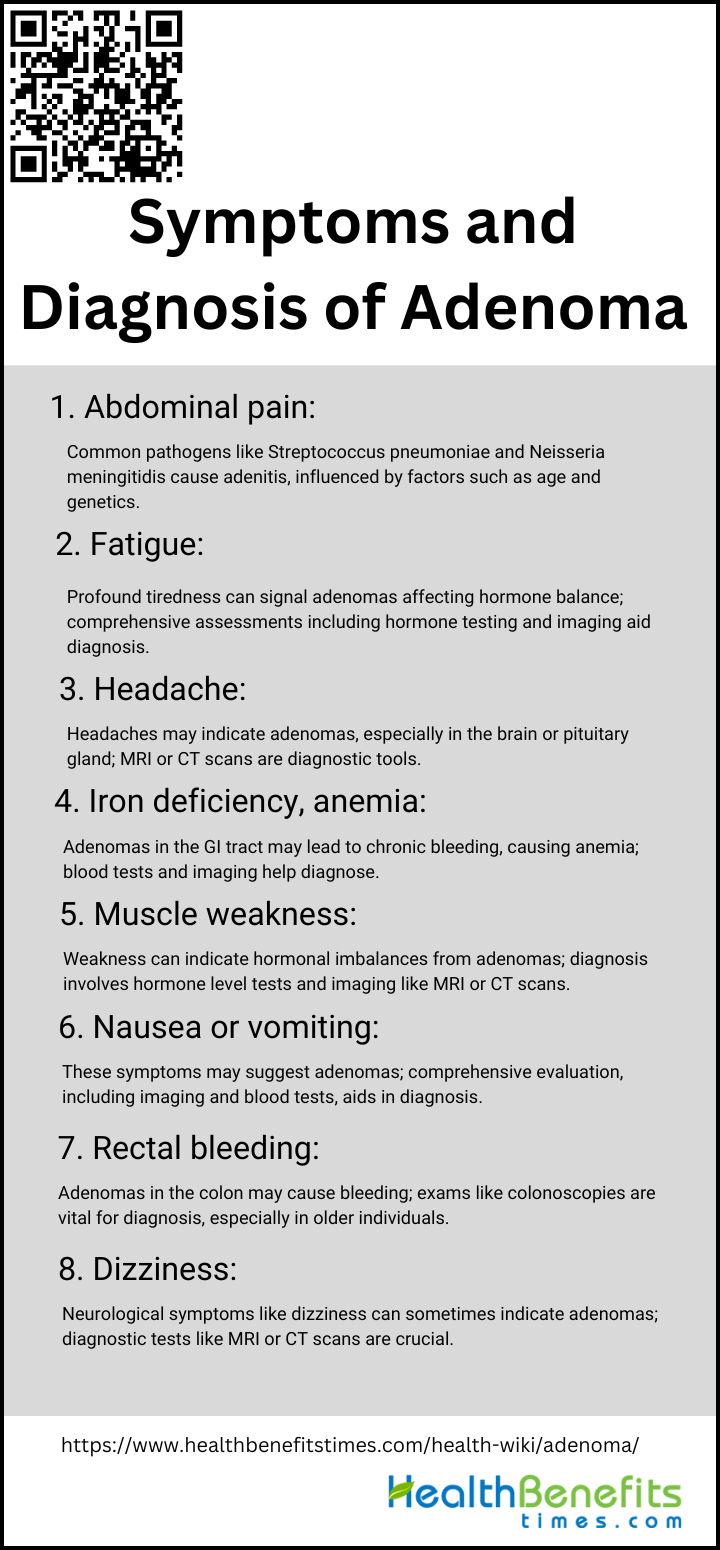
Organs affected by adenomas
Adenomas can affect various organs, with familial adenomatous polyposis (FAP) leading to colorectal carcinoma and other malignancies in the thyroid, stomach, and small intestine. These growths commonly arise in the colon as polyps, which have the potential to progress into colorectal cancer if not detected and treated promptly, underscoring the importance of regular screenings. Similarly, adenomas in the endocrine system, such as those found in the pituitary or thyroid glands, can disrupt hormonal balance, leading to conditions like Cushing’s disease or hyperthyroidism. Adenomas can also affect the liver, although this is rare, and may carry a risk of bleeding or malignant transformation, particularly in individuals taking certain medications. Understanding the diverse impacts of adenomas on the body is crucial for proactive health management and aligns with a holistic approach to wellness that recognizes the interconnectedness of our bodily systems.
- Colon
- Pituitary gland
- Thyroid gland
- Breasts
- Adrenal gland
- Kidneys
- Renal
- Parathyroid
- Liver
- Appendix
- Bronchial
- Sebaceous
- Salivary glands
- Prostate
Diagnosis methods of Adenoma
Understanding the types, causes, and symptoms of adenomas is crucial for effective diagnosis and management. Here are the key methods used in the diagnosis of adenomas, each playing a vital role in ensuring accurate identification and subsequent treatment planning.
1. Colonoscopy
Colonoscopy is the gold standard for adenoma detection, offering direct visualization and the ability to biopsy or removes suspicious lesions. High-definition colonoscopes, whether using white light or narrow band imaging (NBI), have shown high adenoma detection rates, including small and flat adenomas. By using a colonoscope, a flexible tube with a camera, doctors can thoroughly inspect the colon and rectum, identifying any abnormal growths, assessing their characteristics, and removing them if necessary. This not only aids in diagnosis but also allows for immediate treatment, which significantly lowers the risk of polyps developing into cancer. Embracing a holistic health perspective, regular colonoscopy screenings are advised for individuals over 45, or sooner for those with a family history of the disease, as a proactive step in maintaining colorectal wellness and preventing cancer.
2. Virtual colonoscopy
Virtual colonoscopy, known as CT colonography, is a minimally invasive diagnostic tool that uses CT scans to create detailed images of the colon and rectum, offering a less intrusive option for those who might face complications from traditional colonoscopy or prefer a faster recovery. This method is adept at identifying larger adenomas, precursors to colon cancer, with a high degree of accuracy, though it is not as sensitive to smaller polyps. Computed tomographic (CT) virtual colonoscopy has shown high sensitivity and specificity for detecting adenomatous polyps, with a sensitivity of 93.8% for polyps ≥10 mm and a specificity of 96.0% for the same size range. For patients who cannot undergo traditional colonoscopy due to sedation risks or other health conditions, virtual colonoscopy is beneficial. However, if adenomas are found, a conventional colonoscopy is required for removal. Embracing a holistic health approach, virtual colonoscopy reduces the physical strain and discomfort for patients, yet it still necessitates the same bowel preparation as the standard procedure.
3. Flexible sigmoidoscopy
Flexible sigmoidoscopy (FS) is a key diagnostic method for adenomas, particularly effective in detecting neoplasms in the distal colon and rectum. Studies show FS alone has a sensitivity of 67% for adenomas, which increases to 75% when combined with fecal immunochemical tests (FITs). By inserting a sigmoidoscope—a flexible tube with a camera—into the rectum, healthcare professionals can inspect the lower colon’s lining, identifying and potentially removing polyps to prevent colorectal cancer. This diagnostic method is less extensive and requires less preparation than a full colonoscopy, often without the need for sedation, making it a more patient-friendly option. Recommended for adults over 50 and repeated every 5 to 10 years with normal results, flexible sigmoidoscopy strikes a balance between thoroughness and minimal discomfort, underscoring the importance of early detection and the integration of modern medical diagnostics into a well-rounded approach to health maintenance.
4. Stool test
Stool tests, such as the fecal immunochemical test (FIT) and the multi-target stool DNA test, serve as crucial, non-invasive tools for the early detection of adenomas, the precursors to colorectal cancer. By examining stool samples for hidden blood and specific DNA markers, these tests can reveal early signs of polyps or cancer, enabling proactive health measures. Integrating these tests into regular health routines aligns with holistic wellness principles, focusing on prevention and early intervention to maintain digestive health and avert the progression of serious conditions. Their simplicity and effectiveness make them a cornerstone of health strategies aimed at detecting and addressing colorectal cancer risks promptly.
5. CT Scan
CT scans are pivotal in diagnosing adrenal adenomas. A study showed that CT histogram analysis could differentiate adenomas from non-adenomas with high sensitivity and specificity, surpassing the traditional 10 Hounsfield unit threshold. This non-invasive imaging technique harnesses X-rays to produce detailed images of the body’s internal structures, allowing for a precise assessment of a tumor’s size, shape, and location. Adenomas, particularly those in the adrenal glands that often contain fat, are clearly identifiable on CT scans due to their lower density measured in Hounsfield units. The clarity and specificity of CT scans support healthcare providers in devising individualized treatment plans, which is essential for holistic health practices that prioritize patient-centered care and overall wellness. Early detection through CT scans is crucial, as it can prevent potential complications and the risk of benign tumors turning malignant, reinforcing the importance of this technology in maintaining health and well-being.
6. Biopsy
Biopsy is a critical diagnostic tool for adenomas, but it has limitations. Endorectal ultrasound (ERUS) can improve the accuracy of biopsy in rectal adenomas, detecting cancer in 81% of cases initially misdiagnosed. By examining these samples under a microscope, pathologists can determine the nature of the growth, discerning whether it is benign or potentially cancerous. This critical insight guides the development of a tailored treatment plan that honors the holistic wellness philosophy, focusing on a balanced, patient-centered approach to health. Employing various biopsy techniques such as needle, core, or surgical options, depending on the adenoma’s characteristics, the process is designed to be safe and precise, often utilizing imaging for accuracy. The results from a biopsy are instrumental in shaping effective management and treatment strategies, ensuring patients receive care that aligns with their overall well-being.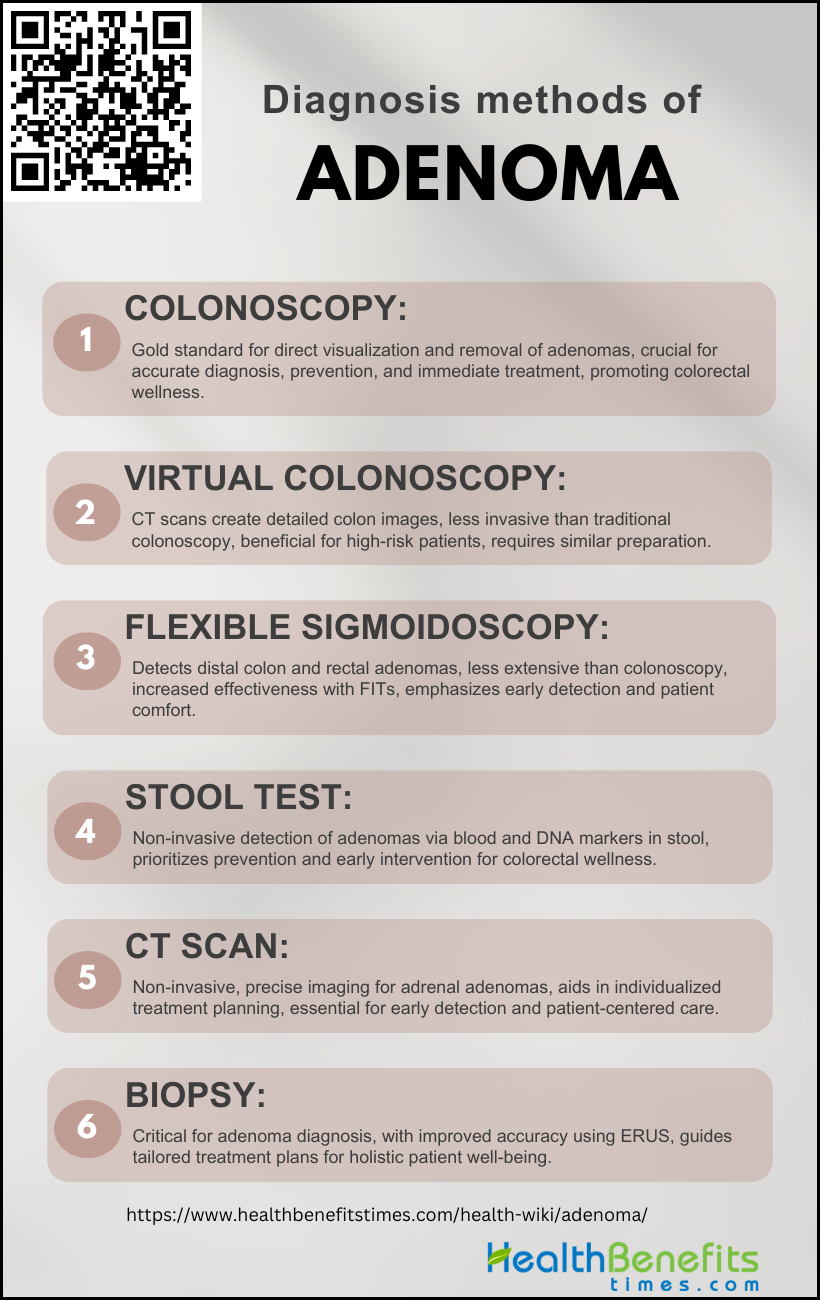
When to contact a doctor regarding adenoma
Understanding when to seek medical advice for an adenoma is crucial for maintaining your holistic health and well-being. Below is a list of signs and symptoms that warrant contacting a doctor to ensure you receive the appropriate care and peace of mind.
- New Symptoms: If you experience new or unusual symptoms such as unexplained weight loss, changes in bowel habits, blood in stool, or abdominal pain, it’s important to consult a doctor.
- Growth or Changes: If you have a known adenoma and notice it has grown in size, changed in appearance, or become painful, seek medical advice.
- Hormonal Imbalances: Some adenomas, like pituitary adenomas, can cause hormonal imbalances resulting in symptoms like fatigue, muscle weakness, or changes in menstrual cycles. These warrant a doctor’s evaluation.
- After a Screening Test: If you’ve had a screening test (e.g., colonoscopy, mammogram) that indicates the presence of an adenoma, follow up with a healthcare provider for further assessment and management.
- Family History: If you have a family history of cancerous adenomas or conditions like Familial Adenomatous Polyposis (FAP), regular check-ups with a doctor are crucial for early detection and treatment.
Treatment Options for Adenoma
Adenomas, benign tumors that can arise in various glands of the body, often require careful consideration for treatment. Understanding the range of treatment options available is crucial for those diagnosed with this condition. Here, we explore the conventional and holistic approaches to managing adenomas, aiming to provide a comprehensive overview for individuals seeking both medical and wellness-oriented solutions.
1. Adrenalectomy (adrenal gland removal)
Adrenalectomy, the surgical removal of the adrenal gland, is a primary treatment for adenoma, particularly aldosterone-producing adenoma (APA). This operation is essential for restoring hormonal equilibrium and enhancing overall health. Skilled surgeons may employ minimally invasive laparoscopic techniques, which offer benefits like reduced pain and faster recovery, to perform the surgery. It’s crucial for individuals to have detailed conversations with their healthcare providers to understand the risks and benefits, and to consider holistic pre- and post-operative support to promote healing. By removing the adenoma and rebalancing hormones, adrenalectomy can alleviate symptoms and improve the patient’s quality of life within a holistic wellness framework.
2. Medications
Medication is a key component that complements lifestyle and dietary changes. Hormone-blocking drugs are commonly prescribed to curb the growth of hormonally active adenomas, such as prolactinomas and adrenal adenomas, while nonsteroidal anti-inflammatory drugs (NSAIDs) are effective in shrinking colorectal adenomas. For pituitary adenomas, dopamine agonists, somatostatin analogs, and growth hormone receptor antagonists serve as the first line of treatment to reduce tumor size and regulate hormone production. These treatments, which are less invasive than surgery, are especially helpful for individuals who cannot undergo surgery or have treatment-resistant tumors. It’s crucial for patients to work with their healthcare providers to understand the potential side effects and to tailor these medications within a personalized health plan that leverages the body’s natural healing abilities, ensuring the best possible outcomes.
Prevention and Management of Adenoma
Adenomas, though benign, can pose significant health risks if left unchecked, potentially progressing to cancerous conditions. Understanding the preventive measures and effective management strategies is crucial for maintaining optimal health. This article delves into the various approaches to prevent and manage adenomas, emphasizing holistic health practices alongside conventional medical advice.
1. Lifestyle modifications
Lifestyle modifications play a crucial role in the prevention and management of adenomas. A balanced diet rich in fruits, vegetables, whole grains, and folic acid—particularly from dark-green vegetables—paired with reduced intake of red and processed meats, processed foods, and sugars forms the foundation of a robust prevention strategy. Regular aerobic exercise and maintaining a healthy weight are essential for enhancing metabolic processes and managing weight, which further protects against benign tumors. Additionally, minimizing alcohol and eliminating smoking are critical steps in reducing adenoma risks. For those with hepatic adenoma, ceasing estrogen-containing medications like birth control pills may also be advised. Collectively, these proactive measures not only defend against adenomas but also promote the natural balance of the body, underscoring the interconnectedness of diet, physical activity, and mental health in holistic wellness.
2. Regular screenings and check-ups
Regular screenings and check-ups are essential in the early detection and management of adenomas, benign tumors that may lead to cancer if not addressed promptly. Colonoscopies and flexible sigmoidoscopies are particularly vital for those over 50 or with a family history of colorectal cancer, as they can identify precancerous polyps in the colon. By incorporating these preventive measures into a health-conscious lifestyle, which includes a diet abundant in fiber from fruits and vegetables and low in processed foods, individuals can significantly diminish the likelihood of adenoma development. Moreover, maintaining awareness of the latest health recommendations and having open conversations with healthcare providers contribute to the effective oversight of any potential adenomas, thereby promoting sustained health and wellness.
3. Genetic counseling and testing
Genetic counseling and testing are pivotal in the prevention and management of adenomas, particularly within hereditary gastrointestinal cancer syndromes. Healthcare professionals utilize genetic analysis to pinpoint inherited conditions like familial adenomatous polyposis or Lynch syndrome, which heighten adenoma risk. Genetic counselors play a key role in interpreting test outcomes, guiding patients through personalized monitoring plans, and advising on lifestyle changes to lower risk factors. This strategy not only fosters informed health decisions but also supports early adenoma detection and effective intervention, embodying the core values of health, fitness, and wellness through a focus on personalized, preventative care.
4. Eat a balanced diet
Adopting a balanced diet is fundamental for both preventing and managing adenomas, which are benign tumors with the potential to become cancerous. To prevent and manage colorectal adenomas, a balanced diet plays a crucial role. Consuming a variety of fruits, vegetables, whole grains, and lean proteins supplies the body with vital nutrients, antioxidants, and fiber, which work together to shield cells from damage, curb inflammation, and support overall health. Foods particularly rich in calcium, magnesium, and fiber, such as dairy products and certain plant-based options, are associated with a reduced risk of colon growths and colorectal cancer. To further diminish the risk of adenomas, it’s advisable to minimize the consumption of processed foods, red meats, and alcohol. Embracing this holistic nutritional approach not only targets adenoma prevention but also promotes a healthier lifestyle in line with holistic health and wellness principles.
5. Reduce your alcohol consumption
Reducing alcohol consumption is a key factor in the prevention and management of colorectal adenomas. Excessive alcohol has been associated with a higher risk of these growths, particularly in the colon and rectum. By embracing a lifestyle with reduced alcohol consumption, not only is the risk of adenomas diminished, but overall health is improved through benefits such as better liver function, decreased inflammation, improved sleep, and stronger immune response. Mindful drinking is in harmony with holistic health principles, fostering a balanced internal state conducive to thriving health and underscoring the importance of choices that benefit all facets of well-being. Therefore, cutting back on alcohol is a vital step for those prioritizing their long-term health and aiming to prevent serious health issues.
6. Quit smoking
Quitting smoking is paramount in the prevention and management of adenomas, as smoking is a significant risk factor for the development and recurrence of colorectal adenomas. Smoking cessation not only reduces the risk of adenoma formation but also enhances the effectiveness of cancer treatments and improves survival rates. Stopping smoking not only lowers the risk of these growths but also bolsters overall health, leading to better lung function and circulation, and reducing the risk of heart disease and various cancers. Embracing a holistic health perspective, giving up tobacco is a vital form of self-care that supports the body’s natural healing. Additionally, for those on the journey to quit, support systems and natural remedies like acupuncture, hypnotherapy, and herbal supplements can aid in managing withdrawal and curbing the smoking urge, aligning with a holistic approach to well-being.